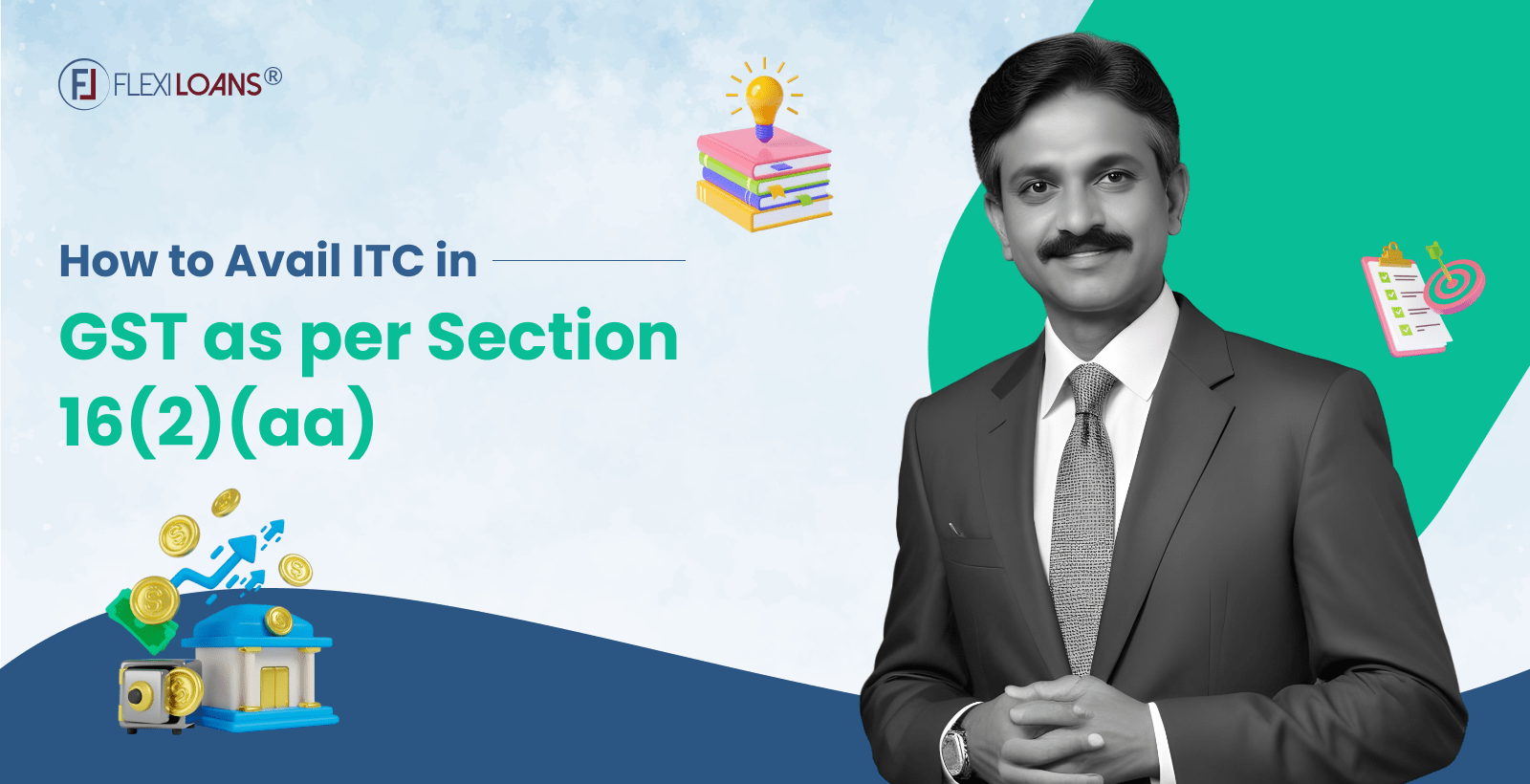Aug 28, 2024
Sep 23, 2025

Navigating the complexities of GST requires a thorough understanding of its rules and regulations. If you want to avail ITC in Goods & Services Tax, particularly under Section 16(2)(aa) of the CGST Act 2017, it’s crucial to comply with the guidelines. Claiming Input Tax Credit effectively reduces your tax liabilities and improves your cash flow.
What is Input Tax Credit Under GST?
The concept of Input Tax Credit under GST allows you, as a registered taxpayer, to claim the credit for the tax you’ve paid on inputs used in your business operations. This mechanism prevents the cascading effect of taxes, where you would otherwise pay tax on tax. When you purchase goods or services for your business, you pay it as part of the transaction. If you use these goods or services for your business, you can claim this levy as credit, reducing your overall liability.
For example, when you purchase raw materials to manufacture products, you pay Goods & Services Tax on these materials. You offset the tax paid on inputs against the tax payable on the output. This practice reduces your overall tax burden and helps maintain competitive pricing. Regularly conducting a credit check ensures that you claim all the credit you’re entitled to, which strengthens your business’s financial health.
Input Tax Credit in GST
The Input Tax Credit mechanism plays a vital role in the system. Section 16(2) of the CGST Act outlines how you can leverage for your business’s benefit. By claiming, you offset the Levy paid on inputs against the tax payable on the output, eliminating the tax-on-tax scenario that existed before Goods & Services Tax. However, you must meet several conditions to avail.
First, you must use the goods or services in the course of your business. Second, the supplier must have paid the tax on these goods or services to the government. Additionally, you can only claim on goods or services that aren’t exempt or subject to a nil rate of tax. Maintaining accurate records is crucial because discrepancies can lead to the denial. By regularly checking your credit status and ensuring that your records align with your claims, you can maximise your ITC and reduce your tax burden.
Eligible and Ineligible Input Tax Credit
You cannot claim on every tax paid under Goods & Services Tax. The CGST Act clearly distinguishes between eligible and ineligible ITC.
- Eligible ITC:
- You can claim eligible ITC on the GST paid for goods or services directly used in your business.
- Example for Manufacturers: A manufacturer can claim ITC on the Goods & Services Tax paid for raw materials.
- Example for Service Providers: A service provider can claim ITC on the GST paid for services directly related to the service they offer.
- Ineligible ITC:
- Personal Use: It includes the GST paid on goods or services used for personal purposes.
- Exempt Goods: You cannot claim ITC on the GST paid for exempt goods.
- Example for Personal Use: If you purchase a vehicle for personal use, you cannot claim on the GST paid for that vehicle.
- Example for Exempt Supplies: If you use goods or services to provide exempt supplies, you cannot claim on these inputs.
- Importance of Understanding ITC:
- Understanding the difference between eligible and ineligible ITC ensures you comply with regulations.
- Properly identifying ITC eligibility helps optimise your Goods & Services Tax returns.
Also read about How to get Tax Saving Tips for SMEs
Can I Claim Input Tax Credit Under GST?
- Eligibility : As a registered taxpayer, you can claim ITC if you comply with the provisions of the CGST Act. This eligibility extends to:
- Manufacturers
- Suppliers
- Agents
- E-commerce operators
- Other business entities
- Possess a Valid Tax Invoice or Debit Note: You need to possess a valid invoice or debit note provided by a registered supplier. This document proves that you paid Levy on the goods or services.
- Receipt of Goods or Services: You must have received the goods or services for which you are claiming ITC. The Goods & Services Tax law does not permit you to claim on goods or services that you haven’t received.
- Supplier’s Payment: The supplier must have paid the GST to the government. If the supplier hasn’t made this payment, you cannot claim.
- Filing GST Returns: You must have filed your Goods & Services Tax returns. Filing on time is crucial to avoid the denial. Meeting this requirement ensures that your claims remain valid and helps you avoid penalties or interest charges.
Conditions to Avail of the ITC Under Section 16 of The CGST Act
- Conditions to Claim:
- Possess a Valid Tax Invoice or Debit Note:
- Ensure you have an invoice or debit note issued by a registered supplier.
- This document proves that you paid GST on the goods or services.
- Receive the Goods or Services:
- You need to have received the goods or services to request ITC.
- Thelaw does not allow you to claim on goods or services that you haven’t received.
- Supplier’s Payment of GST:
- The supplier must have paid the Goods & Services Tax to the government.
- You cannot claim if the supplier has not remitted the duty to the government.
- File Returns on Time:
- You must file your Goods & Services Tax returns on time.
- Timely filing ensures that you avoid the denial of ITC.
- Possess a Valid Tax Invoice or Debit Note:
- Additional Information:
- The CGST Act, specifically Section 16, outlines these conditions to ensure you claim only on legitimate business expenses.
- By meeting these conditions, you ensure your ITC claims are accurate and reduce the risk of penalties or interest charges.
What Amendment Was Introduced?
The government has introduced several amendments to the CGST Act to tighten ITC rules. One significant amendment is Section 16(2)(aa), which requires that you can only claim if the invoice or debit note details are reflected in GSTR-2B. GSTR-2B is an auto-populated form that contains details of all the invoices your suppliers upload. The form is generated based on the GSTR-1 your suppliers file.
With Section 16(2)(aa), you must ensure that your suppliers file their GSTR-1 returns on time and that the invoice details match those in GSTR-2B. If the details don’t appear in GSTR-2B, you cannot claim. This amendment aims to prevent fraud and maintain thesystem’s transparency. Regularly checking your GSTR-2B and reconciling it with your purchase records ensures that you claim the correct amount.
Time Limit to Avail Input Tax Credit Under GST
The CGST Act sets a specific time limit to claim ITC. You must claim within this timeframe, or you lose the right to claim the credit. The time limit is the earlier of two dates: the due date for filing the Goods & Services Tax return for September following the financial year-end of the invoice or the date of filing the annual return. For instance, if an invoice pertains to the 2023-24 financial year, the last date to claim would be the due date for the September 2024 GST return or the annual return filing date for 2023-24, whichever comes first.
If you miss this time limit, you lose the opportunity to claim, which can increase your GST liability. To avoid missing out on valuable tax credits, you should track your invoices systematically and claim within the prescribed timeframe. By staying organised, you can ensure that you don’t lose out on valuable ITC and that your tax planning remains efficient.
Also read about How to get Business Loans
How to Obtain an Input Tax Credit Under GST
To claim you must follow these straightforward steps:
- Gather Necessary Documents:
- Ensure you have all required documents, such as the tax invoice or debit note issued by the supplier.
- Verify that these documents include all essential details, including the GST charged, the supplier’s GSTIN, and a description of the goods or services.
- Confirm Receipt of Goods or Services:
- Check that you have received the goods or services mentioned in the invoice or debit note.
- Ensure that the GST has been paid to the government by the supplier.
- Verify GST Payment:
- Use your GSTR-2B form to confirm that the supplier has filed their GSTR-1 return.
- Check that the invoice details in GSTR-2B match those on your invoice or debit note.
- Claim ITC by Filing GST Returns:
- Include all the ITC you’re claiming for that period in your GST return.
- Ensure you file your returns on time to avoid penalties or interest charges.
- Rectify Discrepancies:
- If discrepancies exist between the invoice details and GSTR-2B, address them before claiming.
- Contact your supplier to correct the invoice details in their GSTR-1 return if necessary.
- Ensure Accuracy:
- Follow these steps to ensure your claims are accurate and compliant with GST regulations.
- Avoid penalties or interest charges by maintaining accurate records and timely filings.
Conclusion
Understanding and complying with the rules for availing ITC under GST is essential for all businesses. By adhering to the conditions laid out in Section 16(2)(aa) of the CGST Act, you can ensure that your claims are valid and that you avoid penalties or interest charges. The introduction of GSTR-2B has made it easier for businesses to reconcile their invoices and ensure that they claim the correct amount of ITC. However, this also means you must ensure that your suppliers file their GSTR-1 returns on time and that the invoice details match those in GSTR-2B.
By regularly checking your GST credit status and claiming all the ITC you’re entitled to, you can effectively manage your business loan obligations and improve your cash flow. Whether you need a loan for business, an online business loan, or a quick business loan, having accurate claims can impact your financial planning positively. FlexiLoans can assist you in obtaining the right business loans online, including machinery loans and collateral-free business loan. Combining a well-managed GST strategy with the financial support provided by FlexiLoans ensures that your business remains on solid financial footing.
FAQs
Section 16 forms the foundation for claiming ITC under Goods & Services Tax. By following the outlined conditions, you ensure that you claim the correct credits, reducing tax liabilities.
It refers to the Input Tax Credit you claim against your output tax liability. This credit reduces your overall burden.
GSTR-2B is an auto-generated form that summarizes all eligible ITC based on supplier invoices. This form helps you match your records with the suppliers’ details.
No, you must have a valid invoice or debit note to claim under Section 16 GST Act.
The time limit is either the due date for filing the return for September of the following financial year or the date of filing the annual return, whichever comes first.
Missing the time limit means losing the chance. This could impact your cash flow and financial planning.
FlexiLoans provides fast and convenient business loans, ensuring you have the financial resources needed to meetobligations and grow your business.
To avail, you must meet conditions such as possessing an invoice, receiving the goods or services, and ensuring the supplier has paid the GST.
Check your GST credit by reviewing GSTR-2B. This form provides a comprehensive summary of all eligible ITC based on your supplier’s invoices.







